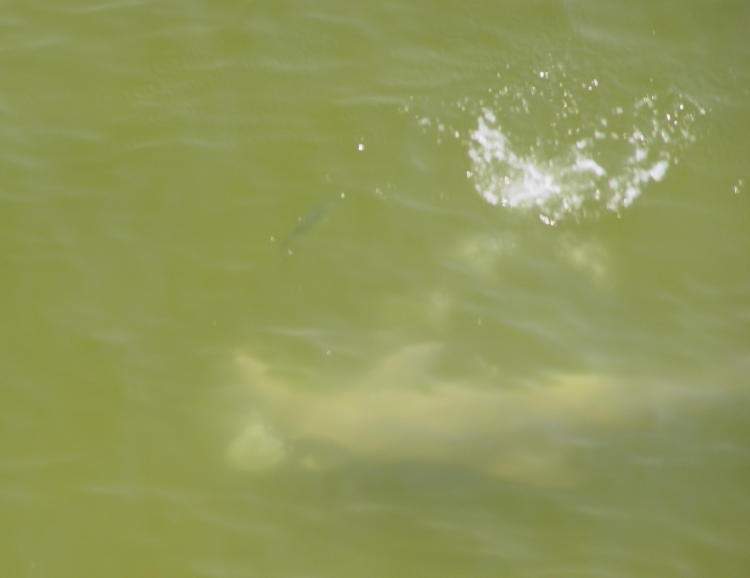
Can you guess the category for today’s Ancient Lore image(s)? No, it’s not ‘Aquatic.’ No, it’s not ‘Beach.’ No, it’s not ‘Lakes/Streams/Waterfalls.’ We’re doing these in alphabetical order, and we last had ‘Leaves/Plants/Trees,’ so what must be next? You should have memorized the order of the folders by now.
That’s right, it’s ‘Mammals,’ a surprisingly underpopulated category among my stock images – you’d think a nature photographer would have a decent selection in there, but I guess I suck. Anyway, that image up there isn’t even the featured one, it just illustrates things slightly better, having been taken the same day and a minute or so before. “Before what?” you say, “Get to the freaking point, Al,” but you should have known by now that wouldn’t work. Anyway, we find ourselves once again atop the causeway, looking down into the Indian River, full name Indian River Lagoon, more specifically the sound behind the barrier islands on the Atlantic, mid-coast side of Florida. It was pretty much salt water, with access to the ocean many kilometers north and south of this region, but broad enough to make numerous ocean inhabitants happy enough, and among them were the Atlantic bottlenose dolphins (Tursiops truncatus.) However, one had to be sharp-eyed to even see them most times, and even faster on the draw with the camera to get any kind of photos, because the typical behavior of dolphins is to surface as if they were cresting the top of a very small hill, exposing their blowhole for about a second before disappearing beneath the surface again. Moreover, this is almost completely unpredictable, far less of a pattern than you might imagine. So even when in prime viewing conditions from the height of the causeway with excellent light, getting a decent shot was challenging, and in fact, after all these years I still don’t have anything that I would consider printable, even with the help of a dolphin tour.
And it’s worse, believe it or not, with autofocus, which needs a certain amount of contrast to lock onto a subject, something that doesn’t often spring up with subjects beneath the surface. Add in the shutter lag for the older digital cameras, and the aforementioned brevity in appearance, and you end up with a very frustrating shooting session – generally, the discarding of numerous shots of blank water, a blurry subject, or if you’re lucky a disappearing tail. Expect to cuss a lot.
The notable aspect of this particular session was, one of the dolphins had been progressing steadily closer, starting to come in right underneath my position (I may have shifted along the bridge to accommodate this, of course,) when it spotted prey, likely a ladyfish or tarpon. Immediately, the placid, ‘strolling’ nature of the dolphin’s progress changed to hot pursuit, and it bulleted through the water after the fleeing fish, easily three times as fast as it had been going. Dolphins, however, are still massive creatures, many times more than its intended prey, so the fish had a distinct edge in maneuverability and used this to good advantage. The dolphin was likely faster, but the fish could turn a lot better, and the chase was something to watch.
At one point, just as the dolphin was almost within seizing range, the fish snapped off to one side and the dolphin attempted to emulate it, twisting so hard during its frenetic chase that it completely overturned, rolling all the way over from its own momentum and utterly destroying any concept of the grace of these sea creatures, and that might be what I captured here.

First off, the intended meal is that dark streak towards the center of the image – the dolphin had indeed been very close. And the wandering autofocus has made its effect known. But you’re seeing the side of the dolphin here; that distinct fin is not the the dorsal (back) fin that we’re all familiar with, but a pectoral, since the dorsal points towards the lower right corner here. You can just make out a hint of the paler underside pointing away from us. The odd shapes up towards the head of the dolphin, to the left, are likely air expelled during the desperate maneuver.
It might well have been more impressive with video, and the camera had the capability, but bear in mind that the chase started abruptly and lasted perhaps eight to ten seconds (the dolphin effectively lost its prey when it rolled over,) so even if I’d been instantly ready to switch, the very act of doing so might have meant capturing nothing, especially with trying to regain focus again on rapidly twisting subjects under the surface. It’s a shame, because I’d love to snag clips like this, but between the demands of the conditions and the sporadic, fleeting nature of such behavior, the chances remain very low – we’ll just have to see what happens. But in the meantime, here’s another story of a hungry dolphin, one that was absolutely breathtaking to see.



















































